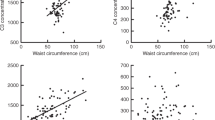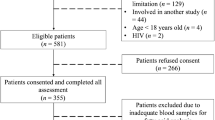Abstract
OBJECTIVE:
To investigate levels of components of the alternative pathway of complement, and of two activation products, ASP and Bb, in persons ranging in insulin resistance both fasting and following the consumption of a high-fat, low-carbohydrate meal.
SUBJECTS:
Healthy controls (n=17) and normoglycaemic first-degree relatives of patients with type II diabetes (n=15).
MEASUREMENTS:
All subjects had normal glucose tolerance. Blood was collected for the measurement of plasma glucose, insulin, triglycerides and free fatty acids. Body composition was assessed with dual energy X-ray absorptiometry (DEXA) and whole-body insulin sensitivity with a euglycaemic, hyperinsulinaemic clamp. Basal and postprandial values over 6 h were determined for plasma C3, B, D, Bb and ASP. Basal levels of C1q, C4 and CRP were also determined.
RESULTS:
Controls did not differ significantly from the relatives of patients with type II diabetes for any metabolic parameter except in their degree of insulin resistance and central fat (kg). Across all subjects, basal levels of C3, but no other complement protein, were correlated with insulin resistance. Native complement proteins, but not ASP or Bb, were correlated with body mass index and the amount (kg) of central fat. Basal levels of C3 and factor B were significantly higher in the relatives group, whereas factor D and the classical pathway proteins C1q and C4 did not differ between the two groups. Postprandially, levels of factor D were significantly reduced in both groups. ASP levels also fell postprandially, the decline achieving significance in the relatives group.
CONCLUSIONS:
Elevated levels of C3 and factor B in the diabetic relatives group may have resulted from increased synthesis by adipose tissue. There was no evidence of alternative pathway activation in response to a fat meal in terms of ASP or Bb production, or significant consumption of C3 and factor B. These data do not support an essential requirement of the hypothesis that ASP is produced in response to the intake of fat.
This is a preview of subscription content, access via your institution
Access options
Subscribe to this journal
Receive 12 print issues and online access
$259.00 per year
only $21.58 per issue
Buy this article
- Purchase on Springer Link
- Instant access to full article PDF
Prices may be subject to local taxes which are calculated during checkout


Similar content being viewed by others
References
Arner P . The adipocyte in insulin resistance: key molecules and the impact of the thiazolidinediones. Trends Endocrinol Metab 2003; 14: 137–145.
Sniderman AD, Maslowska M, Cianflone K . Of mice and men (and women) and the acylation-stimulating protein pathway. Curr Opin Lipidol 2000; 11: 291–296.
McGarry JD . Glucose–fatty acid interactions in health and disease. Am J Clin Nutr 1998; 67: 500S–504S.
Choy LN, Spiegelman BM . Regulation of alternative pathway activation and C3a production by adipose cells. Obes Res 1996; 4: 521–532.
Peake PW, O’Grady S, Pussell BA, Charlesworth JA . Detection and quantification of the control proteins of the alternative pathway of complement in 3T3-L1 adipocytes. Eur J Clin Invest 1997; 27: 922–927.
Gabrielsson BG, Johansson JM, Lonn M, Jernas M, Olbers T, Peltonen M, Larsson I, Lonn L, Sjostrom L, Carlsson B, Carlsson LM . High expression of complement components in omental adipose tissue in obese men. Obes Res 2003; 11: 699–708.
Weyer C, Tataranni PA, Pratley RE . Insulin action and insulinemia are closely related to the fasting complement C3, but not acylation stimulating protein concentration (in process citation). Diabetes Care 2000; 23: 779–785.
Wetsel RA, Kildsgaard J, Zsigmond E, Liao W, Chan L . Genetic deficiency of acylation stimulating protein (ASP(C3ades-Arg)) does not cause hyperapobetalipoproteinemia in mice. J Biol Chem 1999; 274: 19429–19433.
Cianflone K, Xia Z, Chen LY . Critical review of acylation-stimulating protein physiology in humans and rodents. Biochim Biophys Acta 2003; 1609: 127–143.
Charlesworth JA, Peake PW, Campbell LV, Pussell BA, O’Grady S, Tzilopoulos T . The influence of oral lipid loads on acylation stimulating protein (ASP) in healthy volunteers. Int J Obes Relat Metab Disord 1998; 22: 1096–1102.
Carey DG, Jenkins AB, Campbell LV, Freund J, Chisholm DJ . Abdominal fat and insulin resistance in normal and overweight women: direct measurements reveal a strong relationship in subjects at both low and high risk of NIDDM. Diabetes 1996; 45: 633–638.
DeFronzo RA, Tobin JD, Andres R . Glucose clamp technique: a method for quantifying insulin secretion and resistance. Am J Physiol 1979; 237: E214–E223.
Kriketos AD, Sam W, Schubert T, Maclean E, Campbell LV . Postprandial triglycerides in response to high fat: role of dietary carbohydrate. Eur J Clin Invest 2003; 33: 383–389.
Axelsen M, Smith U, Eriksson JW, Taskinen MR, Jansson PA . Postprandial hypertriglyceridemia and insulin resistance in normoglycemic first-degree relatives of patients with type 2 diabetes. Ann Intern Med 1999; 131: 27–31.
Ylitalo K, Porkka KV, Meri S, Nuotio I, Suurinkeroinen L, Vakkilainen J, Pajukanta P, Viikari JS, Peltonen L, Ehnholm C, Taskinen MR . Serum complement and familial combined hyperlipidemia. Atherosclerosis 1997; 129: 271–277.
Koistinen HA, Vidal H, Karonen SL, Dusserre E, Vallier P, Koivisto VA, Ebeling P . Plasma acylation stimulating protein concentration and subcutaneous adipose tissue C3 mRNA expression in nondiabetic and type 2 diabetic men. Arterioscler Thromb Vasc Biol 2001; 21: 1034–1039.
Pickup JC, Mattock MB, Chusney GD, Burt D . NIDDM as a disease of the innate immune system: association of acute-phase reactants and interleukin-6 with metabolic syndrome X. Diabetologia 1997; 40: 1286–1292.
Agrawal A, Shrive AK, Greenhough TJ, Volanakis JE . Topology and structure of the C1q-binding site on C-reactive protein. J Immunol 2001; 166: 3998–4004.
Ault BH, Colten HR . Cellular specificity of murine renal C3 expression in two models of inflammation. Immunology 1994; 81: 655–660.
Pascual M, Steiger G, Estreicher J, Macon K, Volanakis JE, Schifferli JA . Metabolism of complement factor D in renal failure. Kidney Int 1988; 34: 529–536.
Pomeroy C, Mitchell J, Eckert E, Raymond N, Crosby R, Dalmasso AP . Effect of body weight and caloric restriction on serum complement proteins, including Factor D/adipsin: studies in anorexia nervosa and obesity. Clin Exp Immunol 1997; 108: 507–515.
Maslowska M, Vu H, Phelis S, Sniderman AD, Rhode BM, Blank D, Cianflone K . Plasma acylation stimulating protein, adipsin and lipids in non-obese and obese populations (see comments). Eur J Clin Invest 1999; 29: 679–686.
Meijssen S, van Dijk H, Verseyden C, Erkelens DW, Cabezas MC . Delayed and exaggerated postprandial complement component 3 response in familial combined hyperlipidemia. Arterioscler Thromb Vasc Biol 2002; 22: 811–816.
Karpe F, Fielding BA, Ilic V, Macdonald IA, Summers LK, Frayn KN . Impaired postprandial adipose tissue blood flow response is related to aspects of insulin sensitivity. Diabetes 2002; 51: 2467–2473.
Peake PW, Charlesworth JA, Pussell BA . Activation of rabbit C3: studies of the generation of cleavage products in vitro and of their metabolism in vivo. Complement Inflamm 1991; 8: 261–270.
Saleh J, Summers LK, Cianflone K, Fielding BA, Sniderman AD, Frayn KN . Coordinated release of acylation stimulating protein (ASP) and triacylglycerol clearance by human adipose tissue in vivo in the postprandial period. J Lipid Res 1998; 39: 884–891.
Porcel JM, Peakman M, Senaldi G, Vergani D . Methods for assessing complement activation in the clinical immunology laboratory. J Immunol Methods 1993; 157: 1–9.
Mohamed-Ali V, Goodrick S, Bulmer K, Holly JM, Yudkin JS, Coppack SW . Production of soluble tumor necrosis factor receptors by human subcutaneous adipose tissue in vivo. Am J Physiol 1999; 277: E971–E975.
Orban Z, Remaley AT, Sampson M, Trajanoski Z, Chrousos GP . The differential effect of food intake and beta-adrenergic stimulation on adipose-derived hormones and cytokines in man. J Clin Endocrinol Metab 1999; 84: 2126–2133.
Nappo F, Esposito K, Cioffi M et al. Postprandial endothelial activation in healthy subjects and in type 2 diabetic patients: role of fat and carbohydrate meals. J Am Coll Cardiol 2002; 39: 1145–1150.
Author information
Authors and Affiliations
Corresponding author
Rights and permissions
About this article
Cite this article
Peake, P., Kriketos, A., Campbell, L. et al. Response of the alternative complement pathway to an oral fat load in first-degree relatives of subjects with type II diabetes. Int J Obes 29, 429–435 (2005). https://doi.org/10.1038/sj.ijo.0802644
Received:
Revised:
Accepted:
Published:
Issue Date:
DOI: https://doi.org/10.1038/sj.ijo.0802644
Keywords
This article is cited by
-
Short- and Long-Term Effects of Weight Loss on the Complement Component C3 After Laparoscopic Gastric Bypass in Obese Patients
Obesity Surgery (2016)
-
Acute effects of monounsaturated fat on postprandial lipemia and gene expression in first-degree relatives of subjects with type 2 diabetes
European Journal of Clinical Nutrition (2014)
-
Proinflammatory Markers, Insulin Sensitivity, and Cardiometabolic Risk Factors in Treated HIV Infection
Obesity (2009)
-
Oral fat load effects on inflammation and endothelial stress markers in healthy subjects
Heart and Vessels (2009)
-
Influence of a family history of type II diabetes on fasting leptin and adiponectin plasma levels
Mediterranean Journal of Nutrition and Metabolism (2008)



